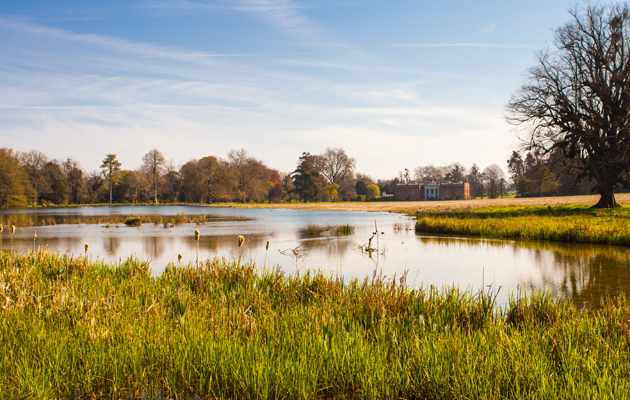Heating your home: water as a renewable energy source
Julie Harding reports on using water as a renewable energy source.


Ed Davey has been championing water as a renewable energy source. Launching an interactive online map last month, which reveals the energy contained in 4,000 UK rivers, estuaries, canals and coastal sites, the Secretary of State for Energy and Climate Change said: ‘We need to make the most of the vast amount of clean, renewable heat that lays dormant and unused in our rivers, lakes and seas.’
Battersea Power Station, the venue for his announcement, was selected because it had just appointed SSE to carry out a water-source heat-pump (WSHP) feasibility study to look into connecting the new 4,000-home, shop and office complex with the River Thames. However, Mr Davey is by no means touting a new idea. Numerous estate owners across Britain are already basking in the reliable heat supplied by WSHPs and the icing on the eco-friendly cake is dramatically lower fossil-fuel bills.
Charlie and Sarah Bullen have a WSHP system at their Georgian manor, Avington Park in Hampshire, a popular film location and wedding and corporate-function venue. Like most historic country houses, Avington wasn’t renowned for its toastiness and friends knew to wear extra layers when visiting. Today, the grand rooms are comfortably warm around the clock and the ultra-efficient water system can supply seven showers at a time.
‘Old houses weren’t made for warmth, so it’s very exciting to find Avington toasty,’ says Mrs Bullen, who realised three years ago that her four ancient oil boilers, the youngest being 18 and the oldest 40, needed replacing. An article in The Telegraph, in which the Hon Simon Howard waxed lyrical about Castle Howard’s 200kW underwater ground-source heat system, prompted her to appoint Ecovision (01666 501580; www.ecovision.com) to install Avington’s WSHP, utilising the nearby tributary of the River Itchen.
A total of 24 200m (650ft) loops were sunk and then filled with non-toxic propylene glycol and a Dimplex 130kW WSHP was connected to the existing radiators. The whole package cost £125,000, but the Bullens, whose oil bills were once a hefty £18,000 a year, are hoping to recoup the outlay in 6–10 years via the Government’s Renewable Heat Incentive (RHI).
‘When a client has a big body of water, it makes sense to use it,’ says Ecovision’s operations director Neil Otter. ‘For people looking for a constant lower-level heat, the system is perfect.’
WSHPs were first mooted as an idea by William Thomson, Baron Kelvin, as far back as 1852. During the 1940s, the UK’s first commercial WSHP was installed at Duke’s Wharf in Norwich, where a modern version is about to be reinstated at the 154-residential-unit complex using water from the adjacent River Wensum.
Sign up for the Country Life Newsletter
Exquisite houses, the beauty of Nature, and how to get the most from your life, straight to your inbox.
Glasgow-based Star Renewable Energy (0141–638 7916; http://neatpump. com)—which sprung to prominence when helping to heat the homes, offices, schools and a hospital in Drammen, Norway, with WSHP technology—is now assessing UK local-authority housing for its suitability for water-source heating.
‘If you’re connected to the grid, you’ll consume 50% less primary fuel and the cost is also 80% lower than burning gas,’ says Star’s director Dave Pearson. ‘As long as the water doesn’t freeze, WSHPs work well and most rivers in Britain only fall below 4 ̊C for 3%–4% of the year. We’ve even proved that large-system WSHPs can heat up to 90 ̊C, allowing buildings of any size to use them.’
But WSHPs are not just suitable for vast country estates, they fit smaller houses, too. Kensa heat pumps have been installed in a variety of locations, from a renovated watermill to Enstone Manor, a historic Oxfordshire farmhouse. Grove Springs, an ‘eco’ house in Drayton, was recently fitted with two pumps by Martin Buffery’s company Eco Heat, one for the underfloor heating system and one for hot water, utilising nearby spring-fed fish lakes.
‘We’re now looking to introduce this technology to an older brick-built country house that’s been converted into apart- ments,’ says Mr Buffery. ‘It doesn’t matter how big the house is and WSHPs are suitable for new or old buildings, although definitely with the proviso that older ones need to be reinsulated to minimise heat loss.’
Did you know?
- A heat pump works by conveying and upgrading the heat from a low-temp- erature source, such as water, air or the ground
- A heat pump will need to use a fossil fuel—electric- ity or gas—to extract heat, but it’s the renewable resource that is enhancing the performance
- You don’t need to live next door to a river to have a water-source heat pump. You may be able to dig a borehole to access water
- There are two main types of WSHP—open loop and closed loop. Avington Park’s system is an example of a closed loop, with the pro- pylene glycol contained within the loops extracting heat from the water and releasing it into the heat pump. In an open-loop system, water from an aquifer/well or large stream or pond is extracted and then fed directly into the heat pump, where the energy raised through compression is extracted as heat
- You may need planning permission to fit a heat pump on a listed building or if you live in a conservation area

How to move an art collection
Relocating can be stressful at the best of times. We reveal the art of moving art.
Country Life is unlike any other magazine: the only glossy weekly on the newsstand and the only magazine that has been guest-edited by HRH The King not once, but twice. It is a celebration of modern rural life and all its diverse joys and pleasures — that was first published in Queen Victoria's Diamond Jubilee year. Our eclectic mixture of witty and informative content — from the most up-to-date property news and commentary and a coveted glimpse inside some of the UK's best houses and gardens, to gardening, the arts and interior design, written by experts in their field — still cannot be found in print or online, anywhere else.
-
 Vertigo at Victoria Falls, a sunset surrounded by lions and swimming in the Nile: A journey from Cape Town to Cairo
Vertigo at Victoria Falls, a sunset surrounded by lions and swimming in the Nile: A journey from Cape Town to CairoWhy do we travel and who inspires us to do so? Chris Wallace went in search of answers on his own epic journey the length of Africa.
By Christopher Wallace Published
-
 A gorgeous Scottish cottage with contemporary interiors on the bonny banks of the River Tay
A gorgeous Scottish cottage with contemporary interiors on the bonny banks of the River TayCarnliath on the edge of Strathtay is a delightful family home set in sensational scenery.
By James Fisher Published
